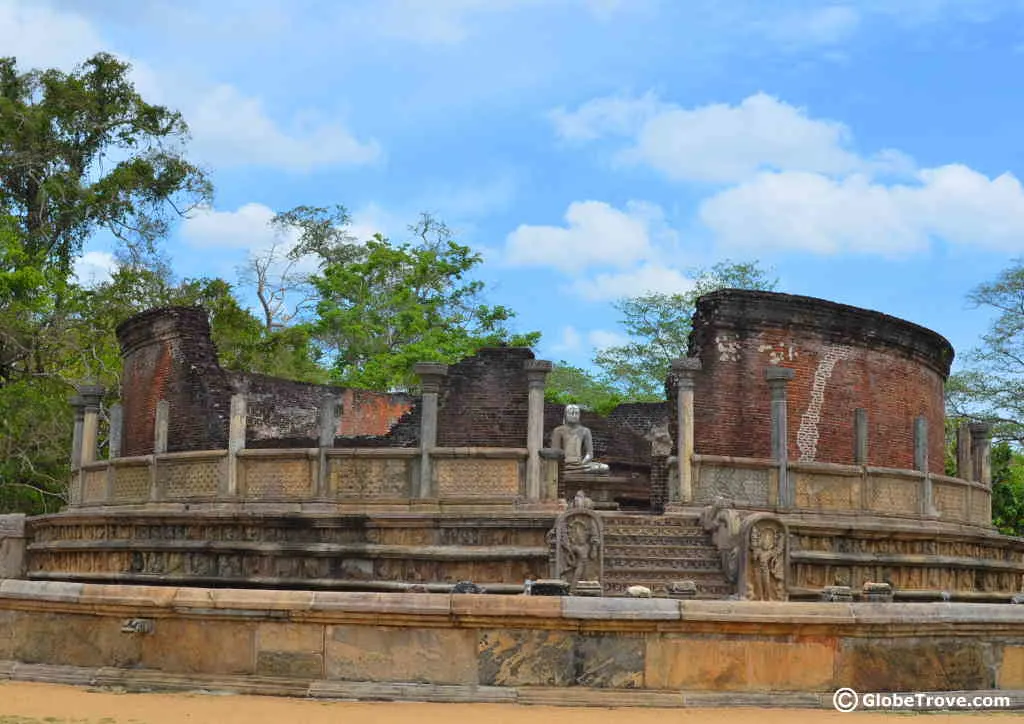Located in the North Central Province of Sri Lanka lies an archaeological gem called Polonnaruwa. It is part of the cultural triangle (which includes Anuradhapura and Sigiriya) but I was surprised that it isn’t quite as popular as the other two.
The reason I was surprised was because I can honestly say that Polonnaruwa was my favourite among the three. It reminded me of Angkor Wat in Cambodia but it covered a smaller area, was not overgrown and was very well maintained. Like Angkor Wat, this too is a UNESCO heritage site. Since I loved it so much, I just had to write about.
This post may contain affiliate links. As an Amazon Associate, I earn a small commission from qualifying purchases at no additional cost to you. Read my disclaimer for further information.
⏰ Not interested in visiting Polonnaruwa on your own? Book a guided tour in advance and let someone else take care of the logistics and lunch! The pickup is from many of the main cities in Sri Lanka! ⏰
Table of Contents
Location And Entrance Fees Of Polonnaruwa
As I said before, Polonnaruwa is located to in the North of Sri Lanka in the North Central Province. A lot of people include it in their day trip from Kandy but in my opinion, it is a rather strenuous trip. Others choose to stay in Polonnaruwa which makes sense because you can get out early and explore the site at leisure.
Other places that you can stay in are in Dambulla and in Anuradhapura which are around 70 kilometres away. We chose to stay in Dambulla and rent a scooter to visit Polonnaruwa. It was a long and beautiful drive.
The entrance fee to Polonnaruwa is 4100 LKR per person. One thing that you should note is that if you belong to a SAARC country and carry your passport along, you get a 50 percent discount which means that you pay just 2050 LKR per person. The tickets are obtained from the museum which is a little away from the main archaeological site.
Exploring the site can be done in a variety of ways. Some people choose to walk around, others rent bicycles and we took our scooter through the whole complex. It worked out well for us especially since we got to visit all the parts of the complex and we reached Polonnaruwa somewhere mid-day.
One thing that we learnt quickly was that we needed to get moving quickly if we saw it all. It was what made us wish, we had reached much earlier.
History Of Polonnaruwa
I’ve often been asked to include a bit of history in my notes about the places that I visit UNESCO heritage sites across the world. So, I’m going to add a brief here. Polonnaruwa today may just be another famous city in Sri Lanka but in the past, it was a kingdom.
It had an inner citadel, an outer citadel, a monastery area and an inner monastery. In addition to this a number of religious buildings were located within the sacred quadrangle.
Polonnaruwa is famous for its significance in agriculture, architecture and sculpture. King Parakramabahu the Great was responsible for constructing a reservoir while King Vijayabahu was the one who restored the irrigation works which were damaged during the invasions at the end of the Anuradhapura era.
When it comes to architecture, you will quickly notice that stone was widely used for construction in the Anuradhapura era. Brick however was used during the Polonnaruwa era. This made construction quicker and easier.
It is also worth noting that these buildings did not fare as well as the stone ones in the centuries to come. They however are being restored by the government now. If you do get a chance to see the before and after photographs in the museum, you will be amazed.
Polonnaruwa is also famous for its sculptures. A large number of these sculptures can be seen in the museum. A few of them can be seen on the walls of the stone structures in the complex.
Etiquette To Observe In Polonnaruwa
I thought that adding a note on the etiquette that one should observe in Polonnaruwa would be a good thing. Most of the stuff was really basic but there were a few things that we had never come across. It is important to know how you are expected to behave in a culture that is different from yours. Sometimes, what may seem perfectly natural to you may not be accepted.
Remember That It Is A Religious Site
It is important to note that Polonnaruwa is both a historical site and a religious one. This means that you should move about the complex with the same respect that you would when you enter a religious monument. This is especially true when visiting the religious shrines that are within. This means that in general your shoulders and your knees should be covered.
Etiquette When Taking Photographs
Do not take photographs with your back towards a Buddha statue. This is considered disrespectful. Selfies would come under this category. If you do want to take a photograph, you can however stand perpendicular to the statue such that your shoulder faces the statue and not your back.
No Plastic Is Allowed In Polonnaruwa
Visitors are not allowed to bring plastic or polythene containers on the site. We did notice that the entire site with the exception of a few spots was kept clean and trash was disposed. Do dispose of your trash in the bins that are provided all over the campus.
Places To Visit In Polonnaruwa
Most of the places to visit in Polonnaruwa are within the archaeological site which requires a ticket to get into. A few lie on the outskirts and don’t require an admission fee. You in all likelihood will start out at the museum because that is where you will get your ticket for the main sites. It is where we started and hence, I will go in the same order that we used when we explore the archaeological site.
1. The Polonnaruwa Museum
The museum in Polonnaruwa is where you will get your ticket. Don’t forget to catch a copy of the information leaflet as you head on. It will guide you through the entire site and will tell you which spots to visit, their names and general information. The museum itself deserves a couple of hours of your time. There are so many ancient artefacts to marvel at.
One of the things that I loved about the museum was the different reconstructions that show you exactly what some of the sites must have looked like in their prime. The museum is open from 7 am to 5:30 pm every day. On certain special occasions the museum is kept open for longer.
2. Potgul Vehera And Potgul Vehera Statue
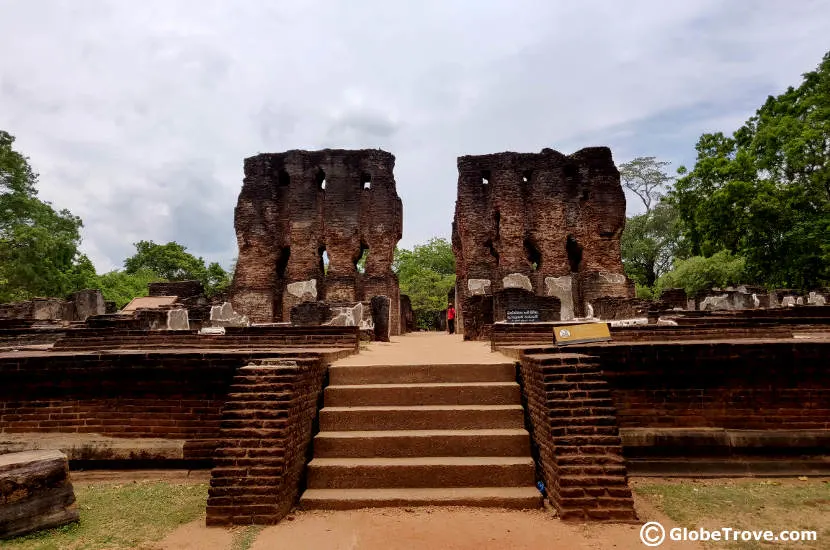
Potgul Vehera in Polonnaruwa.
These two spots were very close to each other and were a short drive away from the main complex. Since none of the ancient text have the name Potgul Vehera in them, scholars are rather doubtful that it was the name that this complex carried.
It has been suggested however that the complex was once called either Kapilla Vihara or Mandala Mandira and was built by King Parakramabahu the Great somewhere between 1153 to 1186 A.D. The name implies that it was a library of sorts and if it was, it could be regarded as the oldest library on the island.
3. The Citadel
As soon as you enter the Polonnaruwa complex, you will head to the citadel. That is the nearest and first spot that we visited. The citadel contains the Royal Palace and the Kumara Pokuna. If you read the inscription next to the Royal palace, you will realize that it was originally a seven storied palace.
The ruins of it however make it rather hard to believe. A little distance away from the palace is the Kumara Pokuna or the royal bath. Just make sure that you head that way, or you could land up missing the spot. The map that you get at the museum will point you in the right direction.
4. The Sacred Quadrangle
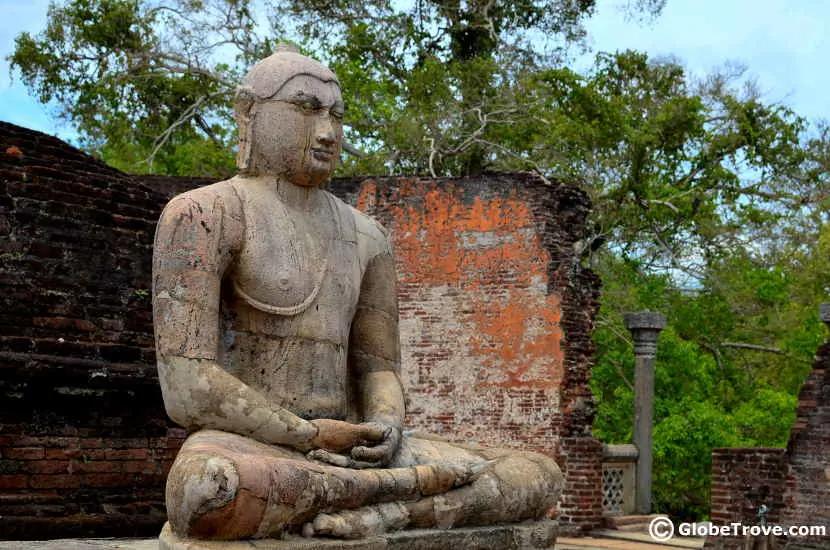
A Buddha in the Sacred quadrangle in Polonnaruwa.
This is definitely a part of Polonnaruwa that you do not want to miss. The Sacred quadrangle contains a lot of the religious structures in the complex. This includes the Thuparama. Interestingly enough, this is the only monument in Polonnaruwa which has its roof well preserved.
The Nissankalata Mandapa is another monument that is particularly noteworthy. The pillars of this monument are rather unusual and resembles a lotus stalk. The Atadage on the other hand is the oldest building in complex.
I can keep on spewing the names of buildings in the quadrangle but the truth is, it is easy to navigate and all the information that you need is on plaques next to each structure.
5. Pabalu Vehera
The Pabalu Vehera provided access to the city from the eastern gate. The name Pabalu Vehera is said to have come from the recovery of beads known as pabalu in the vicinity. There are several images around the stupa.
One of the interesting features of Pabalu Vehera is the three flights of stairs that form a narrow staircase to access to the basal tiers. The access to this staircase is closed.
6. Lankatilaka
Lankatilaka is an image house with a high vaulted ceiling. It is also the largest image house in ancient Sri Lanka. The enormous statue of Buddha inside the Lankatilaka will make you feel very tiny indeed, but it emphasises just how high the original ceiling must have been.
The building is said to have been renovated in the Dambadeniya period (somewhere in the 13th century A.D.). They stone pillars in front of the Lankatilaka are also believed to have formed a pavilion where the hevisi drummers stood.
7. Gal Vihara
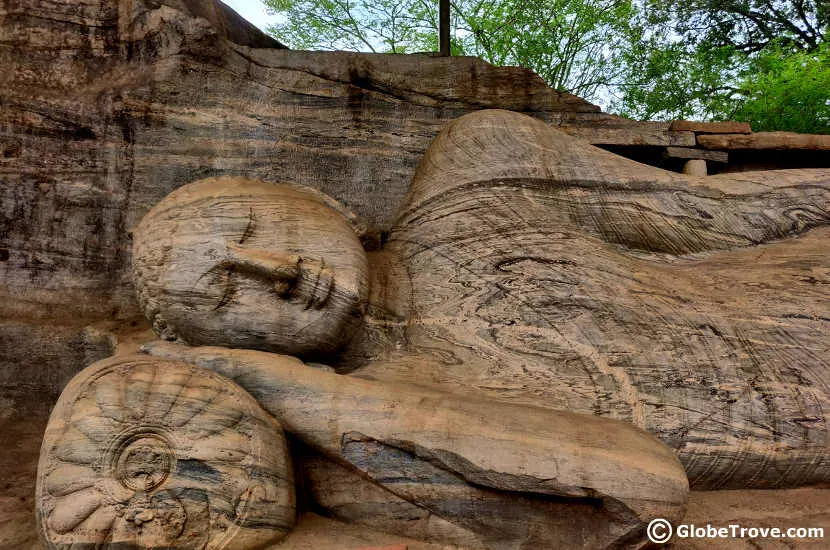
Gal Vihara in Polonnaruwa.
Keep your ticket handy for this one. The Gal Vihara is famous for its statues of Buddha. One particular one stands out. The standing image of Buddha has attracted a lot of attention because of the unusual position of the Buddha’s hands.
Despite the controversy, the images are well known because of their exquisite workmanship. The ruins indicate that there were individual shrines at one point of time. Make sure that you take off your shoes and head up close because you will get a chance to catch a glimpse of some of the ancient paintings that have stood the test of time.
8. The Tivanka Image House
This image house was part of the Jetavanarama monastery. It was built in the 13th century. It gets its name from the word ‘Tivana’ which means ‘Three bends’. This can be seen in the giant Buddha that lies within who is bent in three places namely the shoulder, the hip and the knees.
Another interesting thing to take note of are the ancient paintings on the walls of this monument. You aren’t allowed to take photographs inside the building, so I don’t have one to show you.
I’ve tried to summarize the main parts of the Polonnaruwa complex and there are a number of spots that I haven’t included. The thing is that, Polonnaruwa wasn’t just a citadel, it was a city and a large one at that. Everywhere that you go, you will see remnants of a world that has gone by. It is hard to put the entire experience in words but if I had to try, I would say it was beautiful and surreal.
Tours To Polonnaruwa
⭐️ Rating: 5/5 (4 Reviews) Price: $46 per person Duration: 6-10 hours 📍Meeting Point: Hotel pickup Details: Read more on Viator!
If you aren’t comfortable traveling across the Sri Lankan countryside on a motorbike like we did, I recommend booking a tour to Polonnaruwa. This was the logistics of transport and food are totally taken off your platter and all that you have to do is enjoy taking in the sights.
The best part about this trip is that it has pickup points in Colombo, Dambulla, Sigiriya, Habarana, Trincomalee and amongst other locations. All that you have to do is give them your hotel address and they will pick you up from your doorstep.
The itinerary covers:
- Polonnaruwa Vatadage
- Gal Vihara
- Samudra Parakrama
- Giritale Wewa
- Minneriya National Park (where you can spot elephants in the wild.)
- Ranweli spice garden
- Matale
“We really enjoyed this tour (and the one to Ella the day before with the same company and the same driver Nilanka)! It was very well organised but also gave us the freedom to stop whenever we wished. AirCon car, excellent and safe driving, delicious lunch! The tour guide in Polannaruwa was extremely knowledgeable. Highly recommended, will travel with them again next time we’re in Sri Lanka. :)”
Silvia (read more reviews now!)
Additional information that is worth noting is that the tour is wheelchair accessible, stroller accessible and infant car seats are provided on request.
And there you have it. This covers all the salient points and things that we did in Polonnaruwa. It was a pretty laid back trip and while we may have had a bit of temple fatigue at the end, we sure enjoyed our time there!
Have you been to Polonnaruwa? We would love to hear about your experience in the comments below!
⏰ Not interested in visiting Polonnaruwa on your own? Book a guided tour in advance and let someone else take care of the logistics and lunch! The pickup is from many of the main cities in Sri Lanka! ⏰
Other Posts That You May Enjoy
- Amazing things to do in Trincomalee
- How to get from Ella to Kandy by train
- Exploring the UNESCO site of Anuradhapura
- Trincomalee to Colombo by bus
- Epic things to do in Unawatuna
- Food in Sri Lanka that you will love
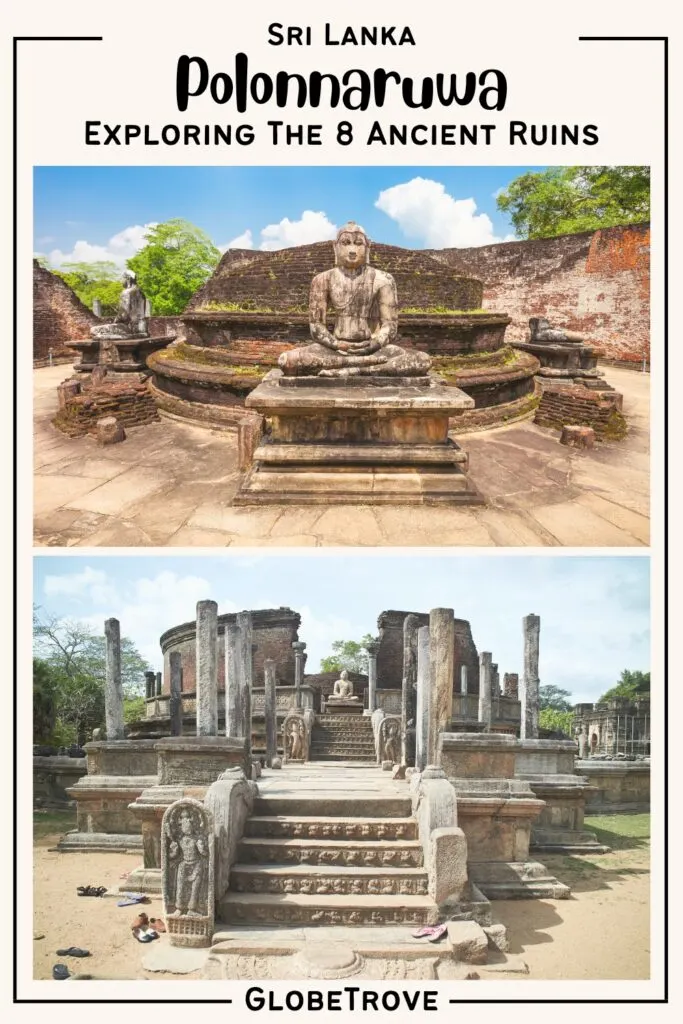

*This post contains Affiliate links

